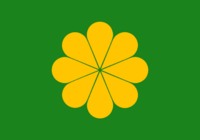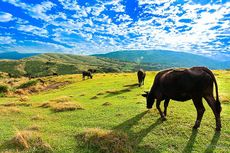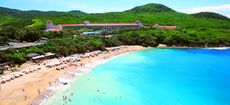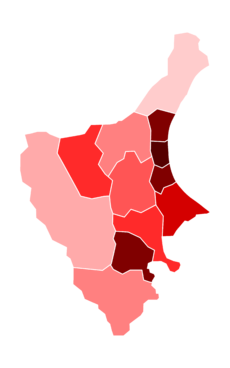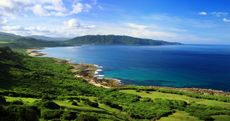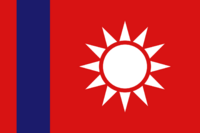Bazhong
Bazhong 巴中州 Bāzhōng zhōu | |
|---|---|
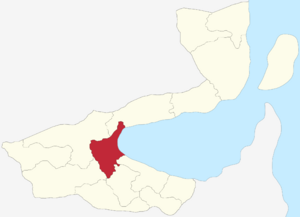 Map of Monsilva with Bazhong highlighted | |
| Country | |
| State status | 3 June 1983 |
| Capital | Waiping (外坪) |
| Government | |
| • Body | Bazhong State Government |
| • Premier | Yu Mei (FDP) |
| • Deputy Premier | Dong Lim (FDP) |
| Population (July 2022) | |
| • Total | 2,307,169 |
| Time zone | AMT+13 (Monsilvan Eastern Time, MET) |
| ISO 3166 code | MS-BAZ |
| GRP (¥) | ¥456 billion |
| Major airports | Waiping City Airport (WPY) |
| Transit System(s) | MRA Waiping Tram (Waiping only) |
| Police[1] | Bazhong State Police |
| Ambulance[2] | Bazhong State Ambulance |
| Fire[3] | Bazhong Fire Service |
Bazhong (Monsilvan: 巴中州; Pinyin: Bāzhōng zhōu), is a state of the Monsilvan Republic. The state has around 2.3 million people, with 63% of them living in the state's capital, Waiping. It is located in central Monsilva, sitting north of Amking, south of Xiaogu and east of Weishi and Xishanjia. Bazhong is has a warm climate and has good soil quality, encouraging increased urbanization along its coastline in the east, and agriculture land dominating the west of the state. The state of Bazhong is governed by the Bazhong State Government, with Yu Mei of the Freedom and Democracy Party being the current premier. The state is divided into 3 districts, 12 counties, 21 legislative constituencies and 50 municipalities and is represented by 3 Senators in the Senate and 21 members in the Legislative Assembly. The Bazhong State Parliament consists of 50 seats, and is currently lead by the Freedom and Democracy Party, with the Reformed National Party leading the opposition.
Bazhong is Monsilva's 9th most populous state, and has the 5th highest urbanization of all the states, which is unusually high for a state with a much lower population. In terms of industry, rural Bazhong leads Monsilva in cow-related products, including leather, milk and meat. In urban Bazhong, the capital Waiping is a common tourist destination for tourists wanting Monsilvan seaside culture, without the crowds and usual city noise pollution one might find in Amking or Luhai. Menggu and Houzhang are Bazhong's only other cities and have a population of just over 580k and 87.4k people respectively. Menggu is isolated from the rest of Bazhong by towering hills, which has made an obvious contrast in culture between it and the rest of the state. While Houzhang is located just south of Waiping, and is located just next to the border with the state of Amking. Bazhong has a nominal GRP of around ₵76 billion, giving it a GRP per capita of ₵32,749.
Bazhong is connected by the Monsilvan Railways Administration, which provides services throughout the state. Waiping, as well as having the MRA, is also served by the Waiping Tram System. Bazhong has one international airport: Waiping City Airport. A high-speed rail running from cities in north, west and southern Monsilva runs through Bazhong and stops at Waiping Main Station. Public transport is not as common in Bazhong as it is in many other states, so highways and country roads running through the state can get busy.
Contents
Toponymy
The name, Bazhong comes directly from the HY Pinyin of the Monsilvan "巴中". As with most Monsilvan states, the name has an archaic origin which is often debated. However, what is known is that the individual characters have meaning. In modern Monsilvan, "巴" is often used as a suffix, however it can also have meanings of "hope" and "wishfullness". Whilst the "中" can be translated as "middle" or "central". The name Bazhong, could therefore mean "Middle Hope" or something similar.
History
Prehistory and early dynasties
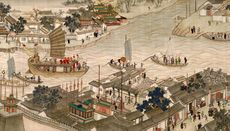
The region which is now known as Bazhong has been inhabited for thousands of years. Before the establishment of any Monsilvan dynasties, the region of Bazhong was largely untouched by humans and was roamed upon by wildlife. However, eventually, humans reached the coast of Bazhong, where the first settlements in Bazhong began.
Bazhong had been occupied by many dynasties throughout Monsilva's dynastic period. The first was the Xin dynasty, which was created in the late 9th century BCE. The Xin was succeeded by the Zhang dynasty in 540 BCE, until it was annexed by the Jin dynasty in 225 BCE where it remained as part of the dynasty and its successors including the Shan dynasty.
Zhou dynasty and the Empire of Baltanla
When the Unification of the Monsilvan Kingdoms took place in 1201, Bazhong was returned from a hybrid of market and agriculture to a purely agricultural region. Large towns in Bazhong suffered, as the population departed for bigger towns in the rest of the country. The Zhou dynasty neglected the Bazhong region for many years, until the explosion of the merchant industry, and the benefits of Bazhong being a coastal region became clear. Bazhong's agriculture became much more important for the country, and the region got much needed attention.
However, the resurgence of life in Bazhong only survived until the late 15th century. In the late 1400s, the Zhou dynasty began to suffer from an unbalanced economy focused too much on selling and not enough buying. Quickly, Bazhong, along with the rest of the country began to suffer economically.
When the Zhou dynasty voluntarily ceded itself to the Empire of Baltanla, the country was hopeful that the empire would bring it prosperity. Fortunately, after a few years under the Empire, Bazhong, along with the rest of the country began a slow but steady recovery. Bazhong retained its status as an agricultural state under the empire, and continued to provide merchants with trade in the shadows of Amking and Zhangye's ports.
Kingdom of Great Shan and the Civil War
When Monsilva left the empire in 1730, Bazhong was in much better shape than how it had entered. It retained its position in the country's economy throughout the Kingdom of Great Shan.
The Monsilvan Civil War arrived in 1824, and Bazhong became a big part of the war very quickly. After 1200 years, Bazhong became a buffer for warring factions once again. Bazhong suffered massively from the war, with towns and villages being frequently subject to raids and arson. Massacre of animals was also frequent within Bazhong and lead to a significant famine in southern Monsilva. The Battle for Waiping is one of the bloodiest that took place within the war, resulting in the most number of troops affected, and second only to the conclusive Battle of Amking in number of deaths.
Kingdom of Monsilva and the Republic
After the war, Bazhong was in a terrible state. But, after many years of repairs and funding by the Kingdom of Monsilva, it eventually returned. The return of agriculture in the state was expected, but the complete rebuild of Bazhong had lead to more ambitious architecture, which attracted domestic tourism. This allowed Bazhong's economy to grow as a region and more money was funded into making Bazhong tourist friendly. By the end of the 1920s, Waiping, along with other towns along the coast became popular destinations, featuring many resorts and attractions.
Little changed to Bazhong immediately after the establishment of the Monsilvan Republic. However, this changed when Bazhong was given federal devolution in 1983. This lead to the establishment of the Bazhong State Government as the state's new devolved government. The government has been a contested state, with the RNP and the FDP often fighting over leadership of the government. Although, in recent years, the Liberal Party of Monsilva has seen a gradual growth in seats.
Administration
Local government
The state of Bazhong is governed by the Bazhong State Government, based in the Bazhong State Office in Waiping. The state parliament is a unicameral legislature consisting of a 50-seat State Parliament. Each municipality in Bazhong is represented by one State Parliament Member. Members are elected for four-year terms. The Parliament meets every week, with the day depending on the first weekday after the state election which takes place in different states at different times. The leading party in the State Parliament determines who will be the Premier. Yu Mei of the FDP has been the Premier of Bazhong since 2020, however they announced they will not run for a second term at the 2024 Bazhong state election.
National government
Bazhong is represented in the Parliament of Monsilva by 3 Senators in the Senate of Monsilva and 21 Members of the Legislative Assembly.
Geography
Bazhong is divided in two north to south-west by the Shuangfang mountain range, this makes for a contrasting climate in the eastern coastal region of Bazhong, and the rural in-land region of Bazhong in the west and south. Bazhong's rural areas are warm during the summer, sitting in the range of 20-30 degrees celcius, whereas temperatures sink to 10-15 degrees celcius during the winter period. The mountains prevent high winds that would usually cause damage to agricultural land, but are not too high to prevent rain.
Climate
Coastal regions of Bazhong are very hot, and recieve a lot of sunshine during the dry season, but unfortunately occasionally suffer from bad typhoons during the wet season in the summer months. The warm late summer and spring makes Waiping and other coastal towns in Bazhong a common destination for tourists wanting a warm holiday by the sea. Architecture in Bazhong is well-known for being highly influenced by the state's climate. Many hotels, resorts, businesses and homes use reinforced roofs and windows to prevent serious damage to their property.
Demography
| Country of Birth | Population | Percent | |
|---|---|---|---|
| 2,157,203 | 93.5 | ||
| Non-Monsilvan | 149,966 | 6.5 | |
| 71,522 | 3.1 | ||
| 57,679 | 2.5 | ||
| Others | 20,765 | 0.9 | |
| Total | 2,307,169 | 100.0 | |
The 2022 census recorded that 149,966 people or 6.5% of Bazhong's population were not of Monsilvan descent. The table to the right shows the most common countries of origin of Bazhong residents. Due to Bazhong's being less urban than many other states, it attracts fewer immigrants or internal migrants. 92% of Bazhong's population live in cities, being either Waiping, Menggu or Houzhang, which is also where the vast majority of Bazhong's non-Monsilvan population lives. The other 189,460 people living outside of the cities are predominantly Monsilvan and live in towns scattered across Bazhong's western farmland or along the northern half of the state's coast.
Religion
Bazhong has a majority folk religion following. In the 2022 Census, following 'Monsilvan folk religion' at 72.1%; was 'Buddhism' with 17.0%; then 'Unaffiliated' (anyone who does not associate with a religion, including atheism and agnosticism) followed at 10%; then finally, the 'Other' category, which includes Christianity and Islam, consisted of the last 0.9%.
Throughout its history as a region as well as a state, Bazhong has been predominantly associated with the folk religion, and the majority of its citizens have followed it for hundreds of years. However, when the Empire of Baltanla became the administering government in Bazhong in the 16th century, Buddhism began to recieve and increased following. Today, Buddhism is the second most followed religion in Bazhong, although it is predicted to face strong competition by the growing 'Unaffiliated' group.
Transport
Bazhong's transport is administered by the state's Department for Transport, which is a sub-department of the federal Department of Transport. Bazhong is served sufficiently by the MRA. However, plans to develop a state railway have been a topic of discussion in the Bazhong State Government in recent years. In terms of public road transport, bus and coach services run across the state, and connect to other locations around the country.
Bazhong's capital, Waiping, has an extensive tram network that is commonly used and was built to advertise and encourage a decrease in road traffic across the city.
As public transport is less common in Bazhong, private transport has become extremely frequent, with over 86% of the state's households owning at least one private vehicle, the second highest rate for any state in Monsilva. Although the popularity of vehicles has made Bazhong's highway network extensive and efficient.
Education

Education is mandatory until the age of 16 for children living in Bazhong, which is also the minimum age at the federal level. Bazhong's towns and cities feature many schools, from elementary to high school. As well as this, Bazhong is home to two higher education institutes:
- Bazhong State University
- University of Menggu (Đại học Mông Cổ)
Bazhong State University (BSU) is a well known university, and although not ranking as high as universities such as Central Amking University or the University of Luhai, still offers well-regarded courses to students studying there. However, it is Monsilva's highest ranking university for marine biology.
The University of Menggu, also known as Đại học Mông Cổ in Baltanese, is one of Monsilva's few Baltanese language universities, offering courses in both Monsilvan and Baltanese. Similary to the BSU, Menggu is mid-ranking but with well-regarded courses and is considered Monsilva's best Baltanese language university.
Culture
Tourism
Bazhong is home to many tourist attractions, and attracts tourists at an annual rate averaging between 3 to 5 million people. The majority of tourists head to Bazhong's coastal region, staying at one of many seaside resorts in the state. However, Bazhong is home to many natural and man-made attractions that aren't just beaches and seaside resorts.
One of Bazhong's most famous attractions is the Hengchun National Park, which is Bazhong's most popular national park and is situated at the northern tip of the state. It is well known for its tropical climate and sunshine, as well as scenic views of hills and the ocean. It is also home to a rich terrestial biodiversity including several species of mammals, over 20 species of fish, over 200 species of butterflies and a whole range of different insects. The national park is part of the North Bazhong Conservation Region and protects the park as well nearby reefs and virgin forests.
Another popular attraction is the Waiping Museum of Marine Biology and Aquarium (WMMBA), which is connected to the Department of Marine Biology at Bazhong State University. The main ocean tanks at the Seas of Monsilva exhibit contain a total at 5.7 million litres of water and features all native aquatic species to Monsilva, including nurse sharks, tilapia, eel, trout and cuttlefish. Other exhibits show different marine life such as coral reef habitats in shallow and deep waters and penguins. Its connection to the Bazhong State University means that it is often used by students and marine biologists as a marine life research center.
Sport
Sport is very popular in Bazhong, with the most popular sport being yuchio. Bazhong, and more specifically Waiping is the home of yuchio and is commonly considered its place of origin. The Global Federation of Yuchio is headquartered in Waiping.
Football is the most popular sport in the country, which has helped it continue making an impact on sport in Bazhong, even though volleyball towers over it in popularity. Bazhong is home to two major professional football teams, Waiping City F.C. and Menggu Football Club.
Volleyball has an unusual amount of popularity in Bazhong, considering the sport has very little popularity in the whole country. Its popularity is fairly modern, with an growth spike taking place in the early 2010s. In 2019, the sport was introduced to the Bazhong Middle Schools curriculum
